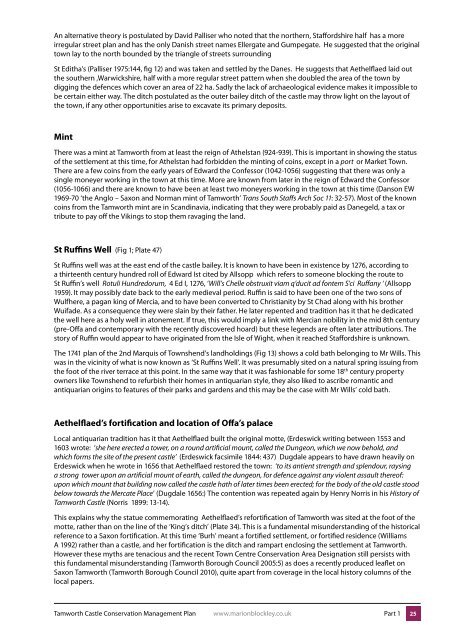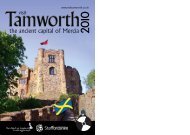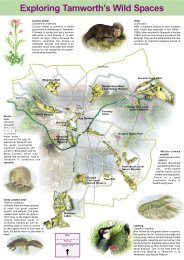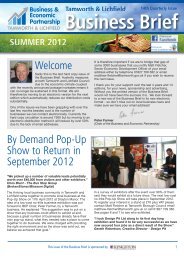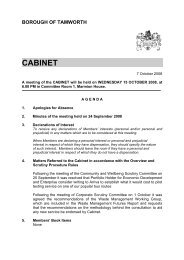Conservation Management Plan - Tamworth Borough Council
Conservation Management Plan - Tamworth Borough Council
Conservation Management Plan - Tamworth Borough Council
Create successful ePaper yourself
Turn your PDF publications into a flip-book with our unique Google optimized e-Paper software.
An alternative theory is postulated by David Palliser who noted that the northern, Staffordshire half has a more<br />
irregular street plan and has the only Danish street names Ellergate and Gumpegate. He suggested that the original<br />
town lay to the north bounded by the triangle of streets surrounding<br />
St Editha’s (Palliser 1975:144, fig 12) and was taken and settled by the Danes. He suggests that Aethelflaed laid out<br />
the southern ,Warwickshire, half with a more regular street pattern when she doubled the area of the town by<br />
digging the defences which cover an area of 22 ha. Sadly the lack of archaeological evidence makes it impossible to<br />
be certain either way. The ditch postulated as the outer bailey ditch of the castle may throw light on the layout of<br />
the town, if any other opportunities arise to excavate its primary deposits.<br />
Mint<br />
There was a mint at <strong>Tamworth</strong> from at least the reign of Athelstan (924-939). This is important in showing the status<br />
of the settlement at this time, for Athelstan had forbidden the minting of coins, except in a port or Market Town.<br />
There are a few coins from the early years of Edward the Confessor (1042-1056) suggesting that there was only a<br />
single moneyer working in the town at this time. More are known from later in the reign of Edward the Confessor<br />
(1056-1066) and there are known to have been at least two moneyers working in the town at this time (Danson EW<br />
1969-70 ‘the Anglo – Saxon and Norman mint of <strong>Tamworth</strong>’ Trans South Staffs Arch Soc 11: 32-57). Most of the known<br />
coins from the <strong>Tamworth</strong> mint are in Scandinavia, indicating that they were probably paid as Danegeld, a tax or<br />
tribute to pay off the Vikings to stop them ravaging the land.<br />
St Ruffins Well (Fig 1; Plate 47)<br />
St Ruffins well was at the east end of the castle bailey. It is known to have been in existence by 1276, according to<br />
a thirteenth century hundred roll of Edward Ist cited by Allsopp which refers to someone blocking the route to<br />
St Ruffin’s well Rotuli Hundredorum, 4 Ed I, 1276, ‘Will’s Chelle obstruxit viam q’ducit ad fontem S’ci Ruffany ‘ (Allsopp<br />
1959). It may possibly date back to the early medieval period. Ruffin is said to have been one of the two sons of<br />
Wulfhere, a pagan king of Mercia, and to have been converted to Christianity by St Chad along with his brother<br />
Wuifade. As a consequence they were slain by their father. He later repented and tradition has it that he dedicated<br />
the well here as a holy well in atonement. If true, this would imply a link with Mercian nobility in the mid 8th century<br />
(pre-Offa and contemporary with the recently discovered hoard) but these legends are often later attributions. The<br />
story of Ruffin would appear to have originated from the Isle of Wight, when it reached Staffordshire is unknown.<br />
The 1741 plan of the 2nd Marquis of Townshend’s landholdings (Fig 13) shows a cold bath belonging to Mr Wills. This<br />
was in the vicinity of what is now known as ‘St Ruffins Well’. It was presumably sited on a natural spring issuing from<br />
the foot of the river terrace at this point. In the same way that it was fashionable for some 18 th century property<br />
owners like Townshend to refurbish their homes in antiquarian style, they also liked to ascribe romantic and<br />
antiquarian origins to features of their parks and gardens and this may be the case with Mr Wills’ cold bath.<br />
Aethelflaed’s fortification and location of Offa’s palace<br />
Local antiquarian tradition has it that Aethelflaed built the original motte, (Erdeswick writing between 1553 and<br />
1603 wrote: ‘she here erected a tower, on a round artificial mount, called the Dungeon, which we now behold, and<br />
which forms the site of the present castle’ (Erdeswick facsimile 1844: 437) Dugdale appears to have drawn heavily on<br />
Erdeswick when he wrote in 1656 that Aethelflaed restored the town: ‘to its antient strength and splendour, raysing<br />
a strong tower upon an artificial mount of earth, called the dungeon, for defence against any violent assault thereof:<br />
upon which mount that building now called the castle hath of later times been erected; for the body of the old castle stood<br />
below towards the Mercate Place’ (Dugdale 1656:) The contention was repeated again by Henry Norris in his History of<br />
<strong>Tamworth</strong> Castle (Norris 1899: 13-14).<br />
This explains why the statue commemorating Aethelflaed’s refortification of <strong>Tamworth</strong> was sited at the foot of the<br />
motte, rather than on the line of the ‘King’s ditch’ (Plate 34). This is a fundamental misunderstanding of the historical<br />
reference to a Saxon fortification. At this time ‘Burh’ meant a fortified settlement, or fortified residence (Williams<br />
A 1992) rather than a castle, and her fortification is the ditch and rampart enclosing the settlement at <strong>Tamworth</strong>.<br />
However these myths are tenacious and the recent Town Centre <strong>Conservation</strong> Area Designation still persists with<br />
this fundamental misunderstanding (<strong>Tamworth</strong> <strong>Borough</strong> <strong>Council</strong> 2005:5) as does a recently produced leaflet on<br />
Saxon <strong>Tamworth</strong> (<strong>Tamworth</strong> <strong>Borough</strong> <strong>Council</strong> 2010), quite apart from coverage in the local history columns of the<br />
local papers.<br />
<strong>Tamworth</strong> Castle <strong>Conservation</strong> <strong>Management</strong> <strong>Plan</strong> www.marionblockley.co.uk<br />
Part 1<br />
25


